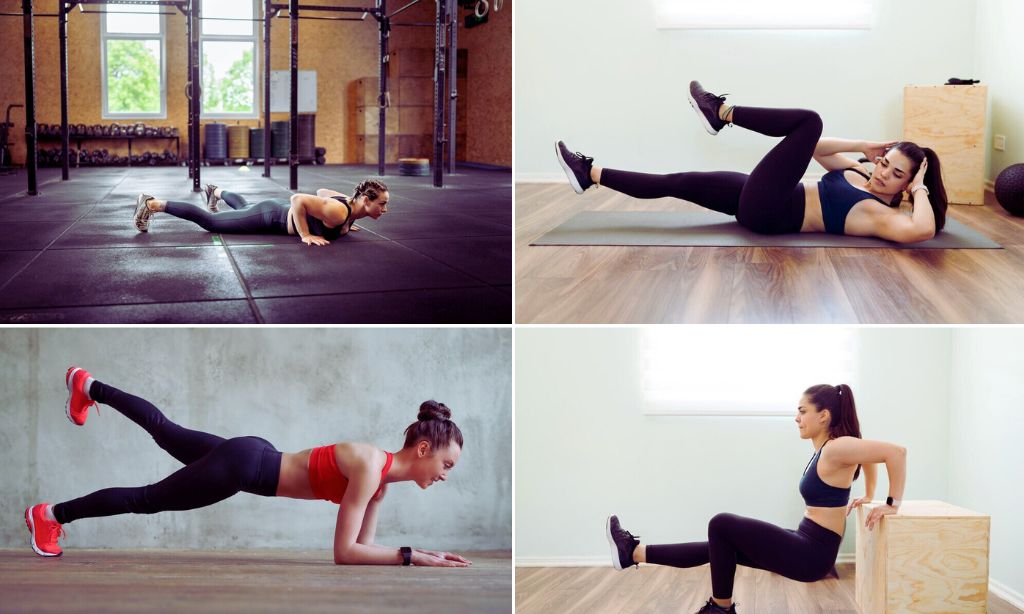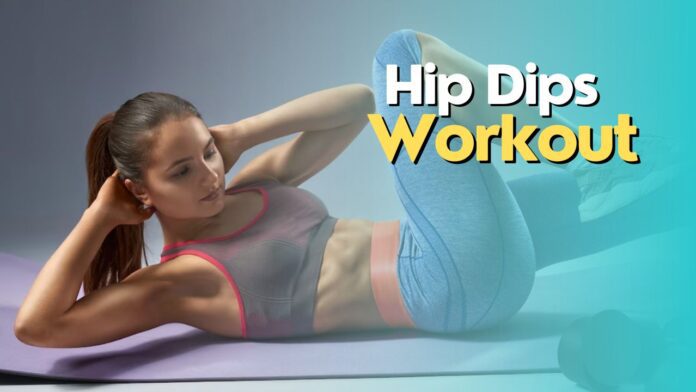Hip dips are a common anatomical feature that many people have. They are the inward depressions on the side of your body right below the hip bone. While they are a natural part of the body, some people may feel self-conscious about their appearance. Fortunately, there are exercises that can help reduce the appearance of hip dips and tone the muscles around the hips.
Skeletal anatomy and genetics play a major role in determining the appearance of hip dip. However, certain exercises can help target the muscles around the hips and reduce their appearance. Building muscle in the glutes and thighs can help create a more rounded and toned look. It’s important to note that while these exercises can help reduce the appearance of hip dips, they may not completely eliminate them.
In this article, we will explore some of the best exercises to target hip dips and tone the muscles around the hips. We will also discuss the anatomy of hip dips and how genetics plays a role in their appearance. Whether you’re looking to reduce the appearance of hip dips for aesthetic reasons or simply want to improve your overall health and fitness, these exercises can be a great addition to your workout routine.
Understanding Hip Dips Workout:
Hip dips refer to the inward curve or indentation that can be seen on some individuals between the hip and the thigh. This is a result of the shape and structure of the pelvis and the way the femur (thigh bone) attaches to it. In this section, we will dive deeper into the anatomy of hip dips, the causes and factors that contribute to them, and dispel some common myths surrounding them.
Anatomy of Hip Dips
The shape of the pelvis, which can vary from person to person, is what causes the hip dips. The pelvis is a bony structure that connects the spine to the femur, and genetics determines its particular shape. The curve of the pelvis can cause the femur to attach at a slightly different angle, resulting in a dip or indentation between the hip and the thigh.
The gluteus medius muscle, which is located on the outer side of the hip, also plays a role in the appearance of hip dips. This muscle attaches to the top of the femur and helps to stabilize the hip joint. If the gluteus medius is weak or underdeveloped, it can contribute to the appearance of hip dips.
Causes and factors
While the shape of the pelvis is the primary factor that determines the appearance of hip dips, there are other factors that can contribute to their development. One of these factors is fat distribution. If a person tends to carry more fat in their hips and thighs, it can accentuate the appearance of hip dips.
Skeletal structure is another factor that can contribute to the appearance of hip dips. Some people have wider hips or a more pronounced curve in their pelvis, which can result in a more noticeable indentation between the hip and the thigh.
Myths vs. Reality
There are several myths surrounding hip dips that need to be dispelled. One of these myths is that hip dips are a sign of being overweight or unhealthy. This is not true. Hip dips are a natural part of the skeletal structure and can be seen in individuals of all shapes and sizes.
Another myth is that hip dips can be eliminated through exercise or diet. While exercise can help to strengthen the gluteus medius muscle and improve overall muscle tone, it cannot change the shape of the pelvis. Likewise, diet and weight loss cannot change the underlying structure of the bones.
In conclusion, hip dips are a genetically determined natural component of the skeletal structure. While exercise and diet can help to improve muscle tone and overall appearance, they cannot change the underlying shape of the pelvis. By understanding the anatomy and factors that contribute to hip dips, individuals can learn to embrace their unique body shapes and feel confident in their own skin.
Benefits of Hip-Dips Workout

Hip dips are a natural feature of the human anatomy, and while they are perfectly normal, some individuals may feel self-conscious about their appearance. Hip dip workout can help to reduce the appearance of hip dips and create a more defined hourglass shape. In addition to aesthetic improvements, hip dip exercises provide a range of benefits, including muscle strengthening, enhanced stability, and balance.
Aesthetic Improvement
Hip dips exercises can help to create a more defined hourglass shape, which is a desirable body shape for many individuals. By targeting the muscles in the hips and thighs, hip dips exercises can help to reduce the appearance of hip dips and create a smoother, more contoured look. While hip dips exercises cannot completely eliminate hip dips, they can help to improve the overall appearance of the hips and thighs.
Muscle Strengthening
Hip dips exercises can also help to strengthen the muscles in the hips and thighs. By targeting these muscles, individuals can improve their overall muscle tone and increase their strength. Stronger muscles can also help to improve posture and reduce the risk of injury during physical activity.
Enhanced Stability and Balance
Hip dips exercises can also help improve stability and balance. By targeting the muscles in the hips and thighs, individuals can improve their overall balance and coordination. This can be particularly beneficial for individuals who participate in sports or other physical activities that require a high level of balance and coordination.
In conclusion, hip dips exercises provide a range of benefits, including aesthetic improvements, muscle strengthening, and enhanced stability and balance. Incorporating hip dips exercises into a regular workout routine can help individuals achieve a more defined hourglass shape, improve their overall muscle tone, and reduce the risk of injury during physical activity.
Targeted Exercises for Hip Dips
Hip dips are a common feature of the human body. They are a natural occurrence and do not pose any health risks. However, some people may feel self-conscious about their appearance. Fortunately, there are several exercises that can help reduce the appearance of hip dips.
Squats and Variations
Squats are one of the most effective exercises for strengthening the glutes and hips. They work the gluteus maximus, gluteus medius, gluteus minimus, and tensor fasciae latae muscles. This helps to lift and tone the hips, reducing the appearance of hip dips.
Some variations of squats that can be helpful for hip dips include:
- Sumo squats
- Bulgarian split squats
- Curtsy lunges
Lunges and Variations
Lunges are another great exercise for targeting the glutes and hips. They work the same muscles as squats but in a different way. Lunges can help to tone and shape the hips, reducing the appearance of hip dips.
Some variations of lunges that can be helpful for hip dips include:
- Reverse lunges
- Side lunges
- Walking lunges
Glute Bridges and Variations
Glute bridges are a great exercise for targeting the glutes and hamstrings. They can help to lift and tone the hips, reducing the appearance of hip dips. Glute bridges work the gluteus maximus and hamstrings, which are important muscles for hip strength.
Some variations of glute bridges that can be helpful for hip dips include:
- Single-leg glute bridges
- Banded glute bridges
- Hip thrusts
Side Leg Lifts and Variations
Side leg lifts are a great exercise for targeting the gluteus medius muscle. This muscle is important for hip stability and can help reduce the appearance of hip dips. Side leg lifts can be done with or without equipment and can be easily incorporated into any workout routine.
Some variations of side leg lifts that can be helpful for hip dips include:
- Clamshells
- Side hip openers
- Fire hydrants
- Donkey kicks
Incorporating these exercises into a workout routine can help to strengthen the hips and reduce the appearance of hip dips. It is important to remember that hip dips are a natural occurrence and should not be a cause for concern. By focusing on hip-strengthening exercises, individuals can feel more confident and comfortable in their own bodies. dditionally, you can also read about- Obesity Rates on the Rise in US, with Young Adults and Minorities Most Affected
Workout Accessories and Equipment
When it comes to working out, having the right equipment and accessories can make all the difference. There are several types of equipment and accessories that can be used to enhance hip dips workouts. In this section, we will discuss the benefits of utilizing resistance bands, dumbbells, and using ankle weights.
Utilizing Resistance Bands
Resistance bands are a great tool for hip dips workouts. They provide resistance that can help to strengthen and tone the muscles in the hip dips area. Resistance bands come in different levels, making them suitable for people of all fitness levels.
One of the benefits of using resistance bands is that they are portable and can be used anywhere. They can be used at home, at the gym, or even while traveling. Resistance bands can be used to perform a variety of exercises, including clamshells, fire hydrants, and lateral leg lifts.
Incorporating Dumbbells
Dumbbells are another great tool for hip dips workouts. They can be used to add resistance to exercises such as squats, lunges, and deadlifts. Dumbbells come in different weights, making them suitable for people of all fitness levels.
Using dumbbells can help to increase the intensity of the workout, which can lead to better results. Dumbbells can also be used to perform exercises that target other areas of the body, such as the arms and shoulders.
Ankle Weights and Their Benefits
Ankle weights are a great accessory for hip dips workouts. They can be used to add resistance to exercises such as lateral leg lifts and donkey kicks. Ankle weights come in different weights, making them suitable for people of all fitness levels.
Using ankle weights can help to increase the intensity of the workout, which can lead to better results. They can also be used to target other areas of the body, such as the glutes and thighs.
In conclusion, utilizing the right equipment and accessories can help enhance hip dips workouts. Resistance bands, dumbbells, and ankle weights are all great tools that can be used to add resistance and increase the intensity of the workout. It is important to choose equipment and accessories that are suitable for your fitness level and goals.
Creating a Hip Dips Workout Plan
Hip dips are a natural part of the anatomy for many people, but some may wish to reduce their appearance through exercise. A hip dips workout plan can help strengthen the muscles around the hips and thighs, leading to a more toned and defined appearance.
Weekly Exercise Regimen
When creating a hip dips workout plan, it’s important to establish a consistent weekly exercise regimen. This may include exercises such as squats, lateral leg lifts, and hip dips. A healthcare professional or personal trainer can help develop a customized exercise plan based on individual fitness goals and current fitness levels.
It’s recommended to exercise at least three times per week, with each workout consisting of 30 minutes to an hour of targeted exercises. Incorporating both strength training and cardio can help maximize results and overall health.
Exercise Progression
As with any exercise plan, it’s important to gradually increase the intensity and difficulty over time. This can be achieved through exercise progression, such as increasing the weight or resistance used during exercises, or adding more reps or sets.
It’s important to listen to the body and avoid pushing too hard, as this can lead to injury. A gradual increase in difficulty can help avoid injury and lead to long-term success.
Monitoring Results
To track progress and make adjustments to the workout plan as needed, it’s important to monitor results. This can be done through before and after photos, body measurements, or simply tracking how many reps or sets are completed during each workout.
By monitoring results, individuals can see how their body is responding to the workout plan and make adjustments as needed to achieve their fitness goals. It’s also important to listen to the body and make adjustments if any pain or discomfort is experienced during exercise.
In conclusion, a hip dips workout plan can help reduce the appearance of hip dips through targeted exercises. By establishing a consistent weekly exercise regimen, incorporating exercise progression, and monitoring results, individuals can achieve their fitness goals and improve overall health.
Nutrition and Lifestyle for Reducing Hip Dips
Dietary Considerations
When it comes to reducing hip dips, nutrition plays a crucial role. A well-balanced diet that is rich in nutrients can help you lose excess body fat and build lean muscle mass. It is essential to consume foods that are low in calories but high in protein, fiber, and healthy fats.
Protein is an essential macronutrient that helps build and repair muscles. It also helps you feel full for longer, which can help you avoid overeating. Some good sources of protein include lean meats, fish, eggs, beans, and legumes.
Fiber is another crucial nutrient that can help reduce hip dips. It helps you feel full and satisfied, which can prevent overeating. Some good sources of fiber include fruits, vegetables, whole grains, and legumes.
Healthy fats, such as those found in nuts, seeds, avocados, and olive oil, can also be beneficial for reducing hip dips. They can help keep you feeling full and satisfied, which can prevent overeating.
Importance of Overall Fitness
In addition to a healthy diet, overall fitness is also crucial for reducing hip dips. Regular exercise can help you lose excess body fat and build lean muscle mass. It is essential to combine both cardiovascular exercise and strength training for optimal results.
Cardiovascular exercise, such as running, biking, or swimming, can help you burn calories and lose body fat. Strength training, such as weightlifting or bodyweight exercises, can help you build lean muscle mass.
It is also essential to maintain an overall healthy lifestyle. Getting enough sleep, reducing stress, and avoiding smoking and excessive alcohol consumption can all contribute to reducing hip dips.
In conclusion, reducing hip dips requires a combination of a healthy diet and overall fitness. By consuming a well-balanced diet that is rich in protein, fiber, and healthy fats and engaging in regular cardiovascular exercise and strength training, you can lose excess body fat and build lean muscle mass. Maintaining an overall healthy lifestyle can also contribute to reducing hip dips.
Common Questions and Expert Advice
Addressing Hip Dip Concerns
Hip dips, also known as violin hips, are a natural body shape that occurs when the hip meets the thighs below the hip bone. Some people may feel self-conscious about their hip dips and may wonder if there are any exercises that can help reduce their appearance.
One common question is whether it is possible to get rid of hip dips. The answer is no. Hip dips are a natural part of the body’s anatomy and cannot be eliminated completely. However, there are exercises that can help build muscle around the hip area, which can help reduce the appearance of hip dips.
Another concern is whether it is possible to build muscle around the hip area naturally and quickly. The answer is yes; it is possible to build muscle naturally, but it may take some time and consistency. It is important to have a balanced diet and exercise regularly to build muscle effectively.
Professional Insights
According to healthcare professionals and personal trainers, there are certain exercises that can help build muscle around the hip area and reduce the appearance of hip dips. Some of these exercises include standing leg lifts, side planks with leg lifts, squats, and lunges.
It is important to note that while these exercises can help build muscle, they may not completely eliminate hip dips. Additionally, it is important to consult with a healthcare professional or personal trainer before starting any new exercise routine, especially if you have any underlying health conditions or injuries.
In conclusion, hip dips are a natural part of the body’s anatomy and cannot be eliminated completely. However, exercises can help build muscle around the hip area and reduce the appearance of hip dips. It is important to consult with a healthcare professional or personal trainer before starting any new exercise routine.
You May Find Interest: The Health Benefits of Eating Eggs Every Day
Conclusion
In conclusion, hip dips exercises can be an effective way to reduce the appearance of hip dips and achieve a more sculpted and confident silhouette. While it’s important to remember that hip dips are a natural part of skeletal anatomy and nothing to be ashamed of, some people may feel self-conscious about them.
By incorporating core-strengthening exercises, corrective side hip movements, and targeted workouts, individuals can work towards reducing the appearance of hip dips. Additionally, collagen supplements and supportive tools can provide nutritional support and help individuals achieve their desired body shape.
However, it’s important to note that there is no guarantee that hip dips exercises will completely eliminate hip dips. Body shape and confidence are complex and multifaceted, and it’s important to prioritize overall health and well-being over achieving a specific body shape.
Ultimately, individuals should approach hip dips exercises with a balanced and realistic mindset, understanding that they can be a helpful tool in achieving a more confident and healthy body but not a solution to all body image concerns.





![10 Countries With the Best Healthcare in the World [Statistical Analysis] Countries With the Best Healthcare in the World](https://articleify.com/wp-content/uploads/2025/07/Countries-With-the-Best-Healthcare-in-the-World-1-218x150.jpg)












![10 Countries With the Best Healthcare in the World [Statistical Analysis] Countries With the Best Healthcare in the World](https://articleify.com/wp-content/uploads/2025/07/Countries-With-the-Best-Healthcare-in-the-World-1-150x150.jpg)










